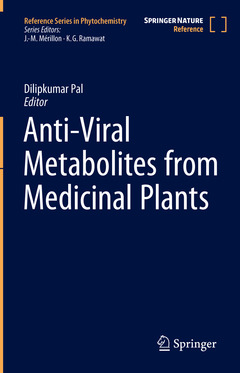Chapter 1 Introduction of medicinal plants as source of anti-viral metabolite(s), effects on health and general adverse effects.- Chapter 2:General plants showing anti-viral activity giving emphasis on CDRI’s biological screening programme.- Chapter 3: Classification of medicinal plants having anti-viral activity as per (i) family and (ii) types of viral infections.- Chapter 4: Ethnopharmacology, Chemistry, Clinical and preclinical studies focusing on use of different medicinal plants against Herpes simplex virus (HSV) Type 1 infections.- Chapter 5: Ethnopharmacology, Chemistry, Clinical and preclinical studies focusing on use of different medicinal plants against Herpes simplex virus (HSV) Type 2 infections.- Chapter 6: Role of various medicinal plants against in HIV infection in human with possible mechanism of action and functions of secondary metabolites.- Chapter 7: Ethnopharmacology, chemistry, clinical and preclinical studies focusing on use of different medicinal plants against Hepatitis B infections.- Chapter 8: Antiviral effects of different medicinal plants against Hepatitis C (HCV) infection: Role of phytochemicals.- Chapter 9: Medicinal plants in controlling Pox virus affections:Ethnopharmacology, chemistry, clinical, preclinical studies and future perspectives.- Chapter 10: Role of medicinal plants in prevention and treatment of Respiratory viral infections.- Chapter 11: Assessment of effectiveness of herbal drugs in prevention and treatment against Gastrointestinal viral diseases.- Chapter 12: Antiviral potential of medicinal plants in treatment of diseases caused by Influenza virus A: Role of secondary metabolites, clinical and preclinical studies and future perspectives.- Chapter 13: Role of medicinal plants in treatment of diseases caused by Influenza virus B and Parainfluenza virus type 3.- Chapter 14: Ethnopharmacology, chemistry, clinical and preclinical studies focusing on the uses of herbal drugs against Polio Infections.- Chapter 15: Ethnopharmacology, chemistry, clinical and preclinical studies focusing on use of medicinal plants against SARS-CoV/Corona virus infections.- Chapter 16: Medicinal plants in controlling and treatment of diseases caused by Viral Haemorrhagic Septicaemia Virus (VHSV).- Chapter 17:Ethnopharmacology, chemistry, Clinical and preclinical studies focusing on use of different medicinal plants against vesicular stomatitis virus (VSV) infections.- Chapter 18: Ethnopharmacology, chemistry, clinical and preclinical studies focusing on use of various medicinal plants against Human Adenovirus Type 1 infections.- Chapter 19: Medicinal plants used by traditional medical practitioner in controlling and treatment of Cutaneous viral diseases: Ethnopharmacology, chemistry, Clinical and preclinical studies.- Chapter 20: Herbal drugs and medicinal plants in controlling and treatment for the diseases caused by Dengue virus (DEN-1 & 2): Ethnopharmacology, chemistry, clinical and preclinical studies.- Chapter 21: Ethnopharmacology, chemistry, Clinical and preclinical studies focusing on use of natural medicinal plants against Neurological viral diseases.- Chapter 22: Ethnopharmacology, chemistry, clinical and preclinical studies focusing on traditional crude drugs against Encephalitis infection.- Chapter 23: Ethnopharmacology, chemistry, Clinical and preclinical studies focusing on use natural plants in the treatment of Renal syndrome caused by viruses.- Chapter 24: Natural products in controlling and treatment of cancers and genital warts caused by different viruses.- Chapter 25: Role of traditional plants in controlling and treatment of fever, joint pain and pogosta diseases caused by viruses.- Chapter 26: Natural medicinal plants used in in controlling and treatment of diseases caused by Coxsackie and Coxsackie virus B3 with possible mechanism of action and role of phytochemicals.- Chapter 27: Phytochemical, clinical and preclinical studies focusing on use Indigenous plants against Cytomegalovirus, Cytomegalovirus B1 and Epstein-Barr virus infection: Prevalence and impact on patients with haematological diseases.- Chapter 28: Flavonoids: promising natural compounds against viral infections: Ethnopharmacology, chemistry, mechanism of action, clinical, preclinical studies and future perspectives.- Chapter 29: Coumarins: emerging antiviral compounds from natural origin: Ethnopharmacology, chemistry, mechanism of action, clinical, preclinical studies and future perspectives.- Chapter 30: Antiviral potential of Curcumins: Ethnopharmacology, chemistry, clinical studies focusing on mechanism of action and future perspectives.




